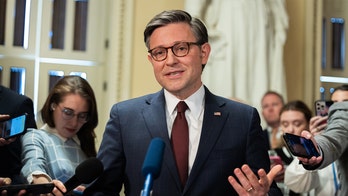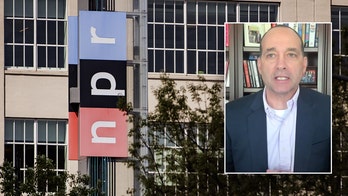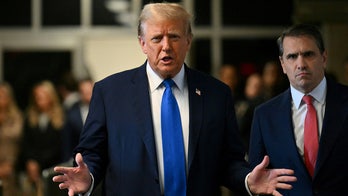Congress is a lot like high school. That’s true. Right down to the bells that signal class.
Like nearly every school, my high school had a bell system. An over modulated, tone would bleat through loudspeakers that hung in every room, springing us from class.
We had four minutes to walk from one classroom to another, use the restroom, or swap out books at our lockers. But multiply four minutes by seven periods and you suddenly have a lot of time on your hands.
Which is when I’d get my business done.
Sure, I’d hit my locker. But this was when I went to find people I needed to chat with. Maybe make plans for the weekend. Chat about the play we were rehearsing. Handicap our basketball team’s chances against Miamisburg. Check out the cheerleading squad.
Diane Edwards even sought me out between classes to accept my prom invitation.
Those bells meant everyone had to go somewhere. A wall of humanity spilled into the corridors during that four-minute window. I’d know the patterns of the people I was seeking. I might doorstep them for a few moments outside of chemistry or even woodshop class.
And like high school, a similar bell system helps me complete my business done each day at the Capitol.
Like a vesper, bells across the House side of Capitol Hill buzzed in a sequence of two at 10:40 last Wednesday morning. The buzzers sounded in hallways, lawmakers’ offices, committee hearing rooms, the Rayburn House Office Building garage and in the cafeteria. Just outside the House steps, a bell that sounds like it once served as a fire alarm at an elementary school in the 1950s also clanged. Then paused. And tolled again. Floor staff from both the majority and minority sides broadcast an e-mail to thousands of House aides and all current members. The message instructed lawmakers to come to the floor for a vote series. Simultaneously, lawmakers’ pagers pulsed. A nasal, male voice explained the condition.
“Two bells from the House Democratic cloakroom,” the voice intoned, “On the Motion to Suspend the Rules, as amended. This is a 15-minute vote.”
The House launched a cluster of four votes. The topics ranged from recognizing special education teachers to saluting Tracy, CA.
And like in high school, the doors of committee hearing rooms and Congressional offices swung open and the House membership poured into the corridors. And rather than stake out chemistry or woodshop, I headed to the second floor of the Capitol.
After all, when the bells ring, I get my work done.
On this day, I have dozens of lawmakers to find in the Speaker’s Lobby. I need to coax a few over to the Will Rogers Statue for an on-camera interview. And there are informal goals, too. I want to take the temperature of the House, talk to people I haven’t seen in a while and remain visible so people can seek me out if they have a story they believe I might take interest in.
Most of the time, the vote on the floor doesn’t make much news. Sure, there are certain big votes that I need to monitor. But votes are primarily an opportunity to mine the House for intelligence and talk to people. Just like in high school between classes.
Members of Congress aren’t guaranteed their bills will get a hearing or even make it to the floor. But they are promised one thing: the right to vote on the House floor. Lawmakers take that right very seriously. Which makes votes ripe pickings for reporters who cover Congress.
I was in the House Rules Committee on the Capitol’s third floor when they called this set of votes. So when they rang the bells I headed down to the second floor to the chamber and started trolling.
Where I go during votes depends on who I’m searching for. For instance, I’ll hang out in the hallway on the Republican side of the chamber if I’m looking for a member whose office is in Rayburn. Rayburn is connected to the Capitol by a tunnel and a bank of three elevators that empties out on the GOP side of the chamber.
Today, I have several lawmakers in my sights. First, I’m hoping to talk to a few players about a bill to fund the war in Afghanistan. So far, Democrats don’t appear to have the votes. So I want to talk to key lawmakers to gauge how they’ll escape that legislative cul-de-sac. I’m also looking for lawmakers from Missouri or involved in veterans issues. There’s word that a Veterans Administration Hospital in St. Louis may have exposed some 1,800 vets to HIV and hepatitis after failing to properly sanitize dental equipment.
I check my BlackBerry to make sure that Rick Cockerham, my photographer for the day, is ready to go at the Will Rogers Statue, just off the House floor. Reporters can talk to lawmakers practically anywhere in the Capitol complex. But the Will Rogers Statue near the chamber’s center door is as close as they permit TV cameras to the floor.
I arrive on the second floor at 10:51 am and visit with Rep. John Lewis (D-GA) and his Chief of Staff Michael Collins. Then my phone rings. It’s Andrew Ricci, press secretary to Rep. Zack Space (D-OH). Ohio Democrats are brawling with House Minority Leader John Boehner (R-OH) over the his criticism of the Wall Street reform bill. Ricci asks if FOX can invite Space and others to the House Radio-TV Gallery for a press conference. Lawmakers must secure an invitation from a news organization to conduct a news conference in the studio. A few seconds later, I receive an email from Tim Mulvey with the office of Rep. Steve Driehaus (D-OH) asking the same thing. I tell them both I need some time. I don’t have a crew available to shoot the press conference. Yet. I shoot our assignment desk an email and stroll into the Speaker’s Lobby for the first time.
The Speaker’s Lobby is the hub of activity during votes. It’s a hallway that runs the length of the House chamber. Lawmakers use the Speaker’s Lobby as an ingress point to the House floor. They conduct informal meetings with staff or fellow lawmakers. Reporters often deploy to the Speaker’s Lobby during votes in hopes of snaring interviews.
An upright desk sits at the back of the Speaker’s Lobby. Chamber Security officials place stacks of white cards around the perimeter of the desk. Journalists fill out these cards and send them into the floor to summon lawmakers to the Speaker’s Lobby. Some lawmakers respond. Others ignore them or simply wish to dodge the press.
I’m mainly focused on the VA story now. So I fill out a handful of cards. I write one up for Rep. Russ Carnahan (D-MO). He wrote to Veterans Affairs Secretary Eric Shinseki about the dental foul-up. Another card is for Rep. William Lacy Clay (D-MO). I’m also looking for House Armed Services Committee Chairman Ike Skelton (D-MO) and the ranking Republican, Rep. Buck McKeon (R-CA). But I wonder how much they’ll know about the topic. They’ve been conducting a major hearing this morning with Army Secretary John McHugh. Officials at Arlington National Cemetery have misidentified more than 200 graves and one service member was buried atop another. I’m also trawling for House Veterans Affairs Committee Chairman Bob Filner (D-CA) and Rep. Steve Buyer (R-IN), the leading Republican on the panel.
I cross to the Democratic side of the Speaker’s Lobby. It’s 11:02 and I have a discrete conversation on the staircase with a senior Republican aide about the Wall Street bill. At 11:04, I spy Rep. Nick Rahall (D-WV) approaching the chamber. Although Rahall isn’t someone I want to interview, I do need to chat with him about funeral arrangements for the late-Sen. Robert Byrd (D-WV). Rahall once worked as an aide to Byrd. I tell Rahall I’d like to chat with him. But suggest he go vote first. He pops into the chamber, votes and comes right back out. We talk for a few moments just outside the Speaker’s Lobby.
The chair closes the first vote at 11:11 am. Now the floor and Speaker’s Lobby are bursting with people. Everyone’s between class. The bells ring again, signaling another vote. This one will name a post office after the late-Sen. Paula Hawkins (R-FL). I won’t track this vote either. One of my quarries, Buck McKeon, materializes. I ask the Congressman if he’s familiar with the hospital in Missouri. He isn’t. I brief him and the California Republican grimaces as I fill him in. McKeon says he needs to learn more about it before commenting. And he reminds me he’s been in the hearing on Arlington Cemetery.
I leave the Speaker’s Lobby at 11:20 and head around the corner over toward the Rayburn Room. Someone hollers my name. It’s Phillip MacNaughton, an aide to Ike Skelton. He asks me why I was looking for the Chairman. I tell MacNaughton about the VA story. Three minutes later, I find Skelton. Like McKeon, he hasn’t heard much about the scandal, either. But he wants to comment. Perhaps later in the afternoon.
I turn around and spot Rep. Emanuel Cleaver (D-MO). I ask Cleaver to please send Clay or Carnahan my way if he spots either of his Missouri colleagues.
I wave to Rep. Joe Sestak (D-PA) who is sitting on a bench making a call outside the speaker’s ceremonial office and then talk to a GOP aide at the base of the grand staircase.
At 11:33, I return to the Speaker’s Lobby and run into Steve Driehaus, who is one of the lawmakers asking me to sponsor their press conference. I tell him I will if I can. But I don’t know yet. He understands.
Moments later, I find out we have a camera to shoot the presser and can invite the Ohio Democrats to the gallery. I ask my colleague John Brandt to cover the press conference. I also phone the House Radio-TV Gallery to notify them of the event. I then notify the two press secretaries who asked me to extend the invitation and tell them we’re set.
The House closes the fourth and final vote at 11:34. The chamber empties as lawmakers return to their offices and appointments. There are a few stragglers. I talk to Rep. Devin Nunes (R-CA) about the World Cup then head back to the Will Rogers Statue. I ask Rick Cockerham to shoot the Democrats’ press conference at 12:30. House Speaker Nancy Pelosi (D-CA) walks by with her security detail and waves.
I never found Carnahan, Clay, Filner or Buyer during this vote series. But there will be more sets later. I return to the Speaker’s Lobby for a final sweep. One of the chamber security officials tells me Buyer and Carnahan looked for me. But I was on the other side of the chamber during the bustle.
I grab a sandwich and yogurt for lunch.
At 12:45, the bells again signal another vote wave. And I head back into the fray. At 1:02 pm, I again talk to Rahall about the Byrd funeral. At 1:04 pm, I see Buyer sprint down a flight of stairs. I briefly give chase but the Congressman says he’s late to meet with some constituents. At 1:10 pm, Ike Skelton’s flak Jennifer Kohl arrives and at 1:15 pm, I interview the chairman on-camera about the hospital. At 1:23, I come around a corner surprised to see both William Lacy Clay and Russ Carnahan waiting to talk about the VA. I track down Rep. Bill Young (R-FL) for an interview about the war spending bill. And moments later, I find a key Democratic aide who gives me some nuggets about the war legislation.
I didn’t get what I needed during the first set of votes. But my labors bore fruit on the second vote series.
Just like in high school. When the bells would ring and I would chase after the people I needed to talk to between classes.
And if I missed them after first period, there was always second period.




